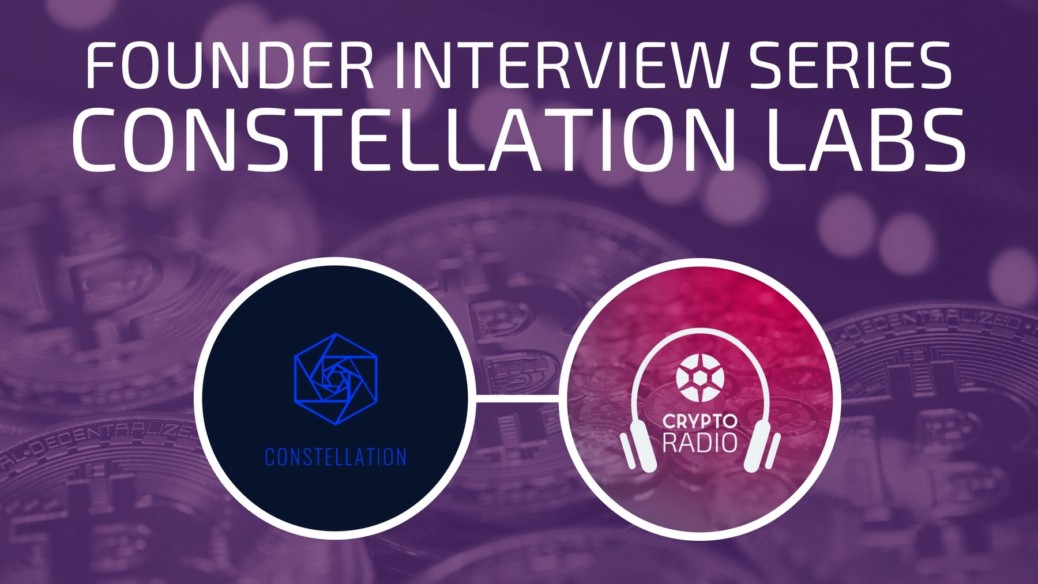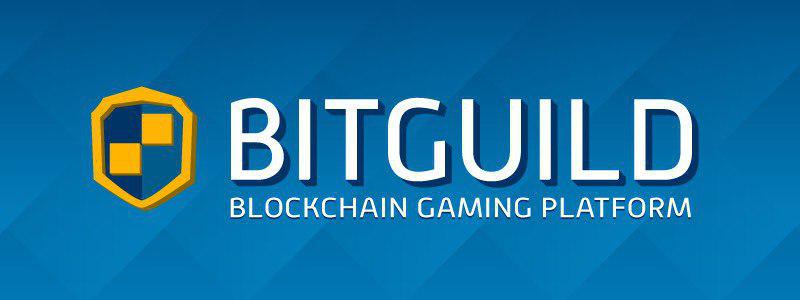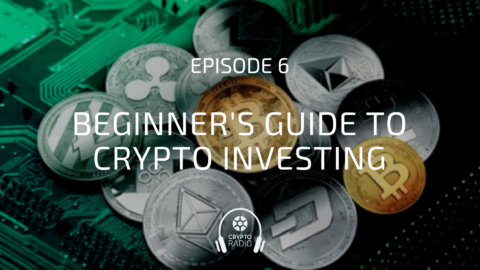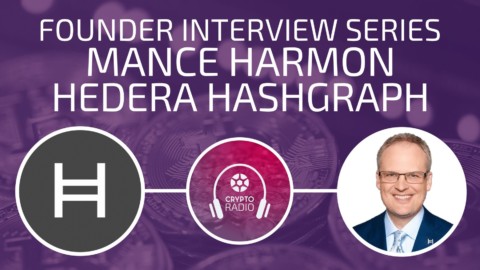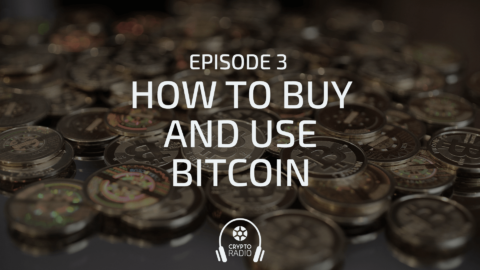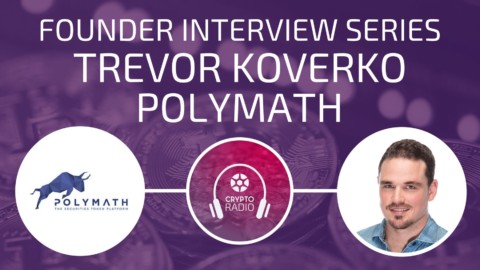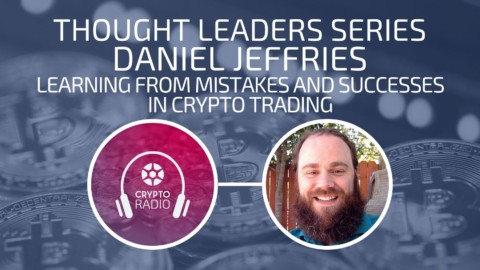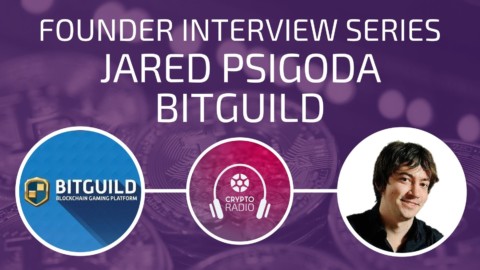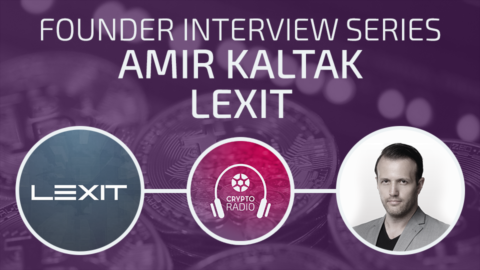Podcast: Play in new window | Download
Euvie: Hi crypto world. My name is Euvie Ivanova and today on the show we have the team behind Constellation Labs as part of our founder interview series. Constellation is a third generation blockchain technology, called a DAG, [00:01:00] which stands for directed acyclic graph. DAGs can scale horizontally and any device connected to the network increases its scalability. Constellation aims to overcome blockchains scaling problems and bring forth a more robust technology. Our guests today are the co-founder and CEO Brendan Playford, head of marketing Zac Russel, and COO Benjamin Jorgensen.
They explain in detail how Constellation works and what it means for the future of distributed technologies. For all the links and show notes, [00:01:30] go to cryptoradio.io/constellation. This episode is brought to you by bitguild.io. Bitguild is a new gaming platform built using blockchain technology. Their mission is to redefine the relationship between gamers and game developers. On the Bitguild platform, gamers maintain full ownership and control of their virtual items, which are stored on the blockchain. They can transfer items and progress between compatible games and they can in-game transactions safely and cheaply, and sometimes free.
[00:02:00] Developers who join the platform will get a direct link to an established player base with a strong community and a network of likeminded developers building on the same platform. Developers will also have the potential for direct game development funding from Bitguild. Bitguild just completed their token sale on April 5th, 2018, in which they raised $35,000 Eth or just over 13 million USD at the current market rate. If you want to find out more, go to cryptoradio.io/Bitguild.
[00:02:30] Alright guys, welcome to the show. Since we have a bunch of you on today, why don’t you just really quickly introduce yourselves so that people can put a voice to your name.
Brendan: My name’s Brendan Playford, I’m [inaudible [0:02:46]. I’ve got a background in physics and maths, and I’ve been in the blockchain space for about four and a half years.
Ben: I’m Ben Jorgensen, I’m the COO and co-founder of Constellation Labs and come from a background in working in [00:03:00] angel investing and entrepreneurship in San Francisco.
Zac: Hi guys, I’m Zac Russel, head of marketing at Constellation Labs. I come from a marketing and media background, focusing on content. I was previously at Red Bull and Vice Media before that.
Euvie: Alright. Hit us with your elevator pitch for the project.
Brendan: Constellation is a DAG chain. We are an unbounded blockchain, a new form of third-generation blockchain and we are creating a mesh net of connected devices, [00:03:30] because they’re mobile combatable, whereby every device that comes to the network increases the scale and characteristics linearly and we have a theoretically infinitely scalable network.
On top of that we’re building a very new reputation model, which is our delegate selection, which is different to proof of work and proof of stake, which is much more meritocratic than existing proof of work or previous state mechanisms.
Euvie: Why did you start the project?
Brendan: We started the project we found that there were inherent limitations in Ethereum, Bitcoin, and, [00:04:00] to be honest, most distributed ledger technology. We really wanted to create a chain that leveraged and made use of all of the unused compute power that’s out there on the nine billion mobile devices and then further laptops, GPUs, and things like that. Collate all those devices together to give this mesh net of connected devices on a DAG and allow people to earn a reward and incentive to giving compute power and, therefore, scaling to our network.
Euvie: Can you tell us a bit about your industry, [00:04:30] especially for those not familiar with it?
Brendan: Yeah. Cryptocurrency is an interesting industry, been around for about seven years with the inception of Bitcoin. Bitcoin was a generation one blockchain which allowed people to store value in a very transparent way. Generation two is something more like Ethereum, which has taken the concepts of stored value and layering on top a compute layer in the way of smart contracts through the Ethereum virtual machine.
Then we’ve moved forward to this newer age of more scalable architecture which is DAG, [00:05:00] or directed acyclic graphs. What that allows for extensible elastic computing and transfer of value over a much more scalable network. In the blockchain space it basically is democratizing people’s ability to transact money fairly and freely and gain access to a network that’s open to all.
Euvie: How are things being done in this industry sector up until this point and what are you guys doing that’s different?
Brendan: People have been doing things very differently in generation one and generation two blockchains. They are [00:05:30] making a technology which is very robust cryptographically, but then struggles with scaling because of that robust nature being synchronist architecture. What we’re doing is we’re taking existing methodology from distributed computing and distributed databases and applying that to blockchain.
Where we were seeing before blockchain coming out as a solution, we’re now taking these two principles of existing distributed computing technology [00:06:00] like Spark or machine learning type methodology, and layering in cryptographic security and tokenization as a monetary policy on top of that.
Euvie: How did you guys get into the blockchain space?
Brendan: Myself personally, I into mining in about 2013. I was mining with GPUs on Doge and Litecoin, then moved to Bitcoin as I grew. What I saw was it gave this really great way of gaining access to financial mobility, which wasn’t otherwise there. I could [00:06:30] simply go out and buy cheap GPU, I could mine some tokens and be involved in a community that was growing and really passionate. From there, move forward economically with freedom I that wouldn’t have got using existing banking or economies in the area that I grew up.
Euvie: What about the other guys?
Ben: Yeah, I got involved. Brendan pulled me into the space and showed me this whole new world that existed beyond the traditional tech and venture capital play in San Francisco. That fit my ideals of alternative [00:07:00] governance in a post-modern capacity.
Zac: I was doing low-level trading in 2017. Similar to Ben, it was Brendan who opened up blockchain beyond cryptocurrencies and its applications beyond simply trading digital assets. When I found out what he was building, jumped on board.
Euvie: What are your competitors in this space? What are they currently doing?
Brendan: Less so competitors, more people that are pioneering this new scalable DAG technology. [00:07:30] There’s two or three that you can compare in a way that means we’re both trying to solve similar problems. That would be, for example, Definity, who’s using randomization as a layer for security with an elastic computing layer. We’re using our consensus model proof of meme, which uses reputation or sharded reputation to enable security of our network.
Then Hashgraph, Hashgraph is pretty similar to us in so much as they are looking at using nodes [00:08:00] to create horizontal scalability. But where they’re very different, they’re only looking at deploying around 30 nodes, whereas we’re looking at deploying a node on every device, which creates a true decentralized network.
Euvie: Aside from that, what else are you doing that’s different from those?
Brendan: I think compared to the entire space, we have two areas where we’re very different. In the business area we are very focused on building a core well classed team to run our foundation. That’s bringing together a blend of industry experts in terms of advisers and [00:08:30] institution investors from the cryptocurrency space. Also, on the other side, traditional in the form of existing entrepreneurs that have come from the Valley and San Francisco, and existing institution angel investors that are also in, you know, we have the fortune of tapping into those in San Francisco and the Valley.
Alongside our tech team that has built major scalable infrastructure for the likes of sales force, [00:09:00] and we’re taking existing technology and applying that to distribute a ledger technology. For example, using JVM, Java virtual machine, to run our smart contract code, which means that immediately open up nine million Java developers globally as opposed to a couple of thousand solidity developers that would otherwise go build on [inaudible [0:09:17].
Euvie: Right. Cool. How far along are you guys with the project right now?
Brendan: In January, we finished our initial fundraising for strategic partners and early institutional investors [00:09:30] and we raised $32,000 Eth in three weeks in January. That gave us the catalyst and the fuel to accelerate building our teams. We’ve spent the last four months meticulously building our team out in San Francisco, Berlin, Singapore, and in LA. We have really four core units. We have business operations, which is working with some outstanding CPA firms in San Francisco to give us a very firm business foundation.
We have our marketing team [00:10:00] with Zac in LA. We have a very strong and robust business development team pulling in the likes of some people from Oracle, people that have worked from Uber, to really grow our partnerships. Then we have product engineering and we have core engineering. Product engineering works on our visible tech, and core works on our actual core framework. We’re at the stage now where we’re ramping up to our token generation event and our second round of funding, going into another phase of funding with accredited and institutional [00:10:30] investors as well as then doing a public token generation event from [inaudible [0:10:34] Foundation at the end of May.
And releasing two things: our test net in June and our first front facing products, our developer and community portal [inaudible [0:10:45], which people get access to with their tokens. That will give different things: incentives for doing development on projects, incentives for doing marketing, incentives for becoming part of the community. You can imagine it’s like a DAC [00:11:00] that we’re launching on Constellation whereby anyone in the community can get support and incentivization to help in contributing to our growth as a network.
Euvie: Cool. Is there anything else as far as your framework goes for the next 6 to 12 months that we should know?
Brendan: Yeah. I think the key is going to be [inaudible [0:11:16] as a portal will give everyone access to our test net. You’ll be able to go in there, get access to support docks. As we develop over the next 12 months within the test environment, there is going to be incremental upgrades to that while [00:11:30] we’re bringing mobile compatibility. You’ll be able to practice running mobile nodes. You’ll also be able to bring in or will be bringing partner DACs to develop in parallel.
We’re not going to wait until our main net launch to get people developing in our framework. We’re going to have people developing and partners developing alongside. A 3D rendering company will be coming on board in July time to develop, all leading up to our main net launch and global node deployment next year.
Euvie: Cool. What are some of the key [00:12:00] milestones and also challenges that will determine your success in this time?
Brendan: I think the biggest thing that we’re going to have is maintain a high-quality core team of developers, and ensuring that we are engaging the broader community and bringing in knowledge that’s outside of the foundation. Doing that in a way that’s both decentralized and well managed is a challenge. We believe there’s building a decentralized network like we’re doing that has to be some form of centralized framework [00:12:30] to get it out to the world.
I think doing that in a balanced way where we’re being transparent, open and honest is going to be a challenge. Having good governance behind that that’s inclusive of the communities will be really important. Again, the key milestones are our test net in June, our TGE actually in May where we’re going to do our small public sale and our strategic round, our second fundraising round, now. All leading up to our main net launch next year.
Euvie: Alright. Let’s come back to talking about your team. How do you guys know each other?
Ben: [00:13:00] Brendan and I met several years ago as we were consulting for numerous mid-market companies on implementing sales and marketing accountability in business operation across the board. That was our first exposure into working together. To give you an idea of our entire core team, the other two people missing from our core foundation are Wyatt, who is our CTO and the brains behind the architecture of the entire platform. You’ll even see [00:13:30] a lot of the math behind what we’re doing come after Wyatt as he’s very vocal on some of that. Then [inaudible [0:13:37], who is our head of community, and is really the mastermind behind building our brand awareness and a strong community and building this pipe.
Euvie: Have you guys worked on other projects together in the past or is this the first one?
Ben: Yeah, Brendan and I worked together for roughly around six months about three years ago and have always [00:14:00] been spit balling entrepreneurial ideas. Wyatt and Brendan met early on and focused on some kind of sprints within the blockchain space, as well. [inaudible [0:14:13] and Wyatt met years ago and have worked together since. We all have worked together in one form or another.
Euvie: Who are some of your guys’ advisers and how deeply are you involves?
Ben: The way that we break down our advisory is basically in this capacity, 25 percent [00:14:30] comes from the academic world, so finding peer reviews for a lot of our math and architecture is extremely important as we take this live. 25 percent comes from business operations and marketing, so how do we take this and scale this incredible world class organization. Another 25 percent is coming from the cryptocurrency community and focusing on how do we work within crypto and blockchain communities that are well established and speak that language.
Then 25 percent, which Brendan alluded to earlier, [00:15:00] which is working with the venture communities. One of the big strengths that we have in being in San Francisco is access to world class tier one venture firms. One example of a partnership that we’re coming out with is [inaudible [0:15:13], which is a tier one venture firm in Silicon Valley that’s focused on emerging markets and consumer-based application. What you’ll see from Constellation is that we have a very strong retail and consumer-based play. That contrives up some of our [00:15:30] break down of advisers. That’s where we are.
Euvie: Is there any other advisers or projects that you want to mention by name that you’re partnered with?
Brendan: Yeah, we’re very fortunate I think in the cryptocurrency space having some deep partners. We’re working with Darius at Connect Capital on a lot of our token model, that includes going as broad as community building, investment, as well, from those guys in an institutional capacity. And more broadly, smaller crypto hedge funds like 1KX, [00:16:00] Scale VR, and more so in the Asia space, we’ve also got partners out there in Korea, Singapore.
Ben: Like NW partners, Chain Rock.
Brendan: Yeah. Then laying on top of that the likes of Tim Chang from Mayfield Ventures, who’s working with us, and other people, as well, we’re building this really robust professional presence in the space and bringing those two sides together so we have the experience and the genetic lineage of Silicon Valley with a deep knowledge of the cryptocurrency space, as well, helping guide us and shape where we’re going.
Euvie: [00:16:30] Why don’t we talk about the tech a bit. Can you explain the value of your token?
Brendan: Yeah. You’ve got to think of our token in much the same way as Ethereum, where the token is required to participate in the network, [inaudible [0:16:47] transactions and enable access to this what is going to be a global mesh net of computing. Initially, we are going to be releasing our token as an ARC20 token, that is going to have utility [00:17:00] by breaking it down to two phases, the first 12 months of development and build up of the test net, that will be driving and incentivizing both, like I said earlier, developers, marketers, and the community to get involved.
You’ll stake the token to gain access to our platform. There’ll be three different tiers, each tier will give you different access. For example, if I’m a developer, I will stake a certain token on the top tier, that will give me access to test nodes, that will give me access to a support desk with actual live people. [00:17:30] I can talk directly with a tech team to get help and support in setting up my nodes. Further, I can get access to a job board which, with partners that we’re bringing on, like we have a 3D rendering partner, they may want to build and ACI, which is an application chain interface, to run let’s say a 3D rendering [inaudible [0:17:47].
They would then put an advert up, stake some Constellation tokens, which was like a county. When the work got completed, that bounty would be paid out to the developer, creating that ACI. The first phase is leveraging [00:18:00] a Constellation token to actually spur the growth and development platform through our portal [inaudible [0:18:04]. Then when we go live with the main net, we’ll do a token switch from native token in our wallets and you would use that to do settlements, cross chain liquidity through our chain complexes will be staked as well, so we can do atomic swaps. The actual entire process of compensating people that have nodes running on mobile devices, those rewards and validate rewards will be paid out in consolation tokens.
[00:18:30] We have a validate reward period for 10 years, which incentives, validates in their consensus rounds, and also if I’m hosting a node that is getting compensation to the network and a 3D rendering company wants to use that to run a job on there, the 3D company will pay that node for a proportional amount of work that’s done into that rendering job. It’s vital that the token is used to access the network without that settlement layer or without our monetary policy running on Constellation, the network simply wouldn’t function.
Euvie: [00:19:00] You guys are building entirely your own brand-new blockchain. Are you going to be having any kind of cross-compatibility with other blockchains?
Brendan: 100 percent. I think that is an incredibly core feature of what we’re doing. We have a belief that there is not going to be one chain to rule them all, we belief that there’s going to be an internet of blockchains of which we are laying out a standard which is why our CTO has invented, it’s based around formal verification [00:19:30] using type theory or category theory to create these para-chain and chain complexes.
What is really interesting about this is that compile time, for example, if you wanted to create a distributed storage solution on Constellation, you wouldn’t launch a token on a smart contract, you would create a para-chain which cross compiles with the Constellation chain and has this notion of atomic swaps with our chain and allows cross-chain compatibility. We can also take that a step further and think about if we’re transacting on Constellation [00:20:00] and, let’s say, Z Cash, you’ll be able to create an ACI between those two chains and, therefore, a chain complex and execute a private key on Z Cash and do an atomic swap between those two chains. We firmly believe that the future is an internet of blockchains, as it were, running on our mesh net of devices.
Euvie: Awesome. Why don’t we talk about marketing, what are your plans for marketing the project?
Zac: You could more or less distil our approach by identifying certain audiences, [00:20:30] specifically people want to generate awareness of our TGE2 who will get involved with the token and stake it. Second to that, identifying and targeting a developer audience, as well. In order to build value our platform we need people to develop decentralized apps. I’m responsible for creating content that pulls in both of those groups. That content can be video content, editorial for the most part, but we’re also looking to leverage [00:21:00] the partnerships that Ben and Brendan have built.
Partnerships that reach beyond our immediate US network. I recently got back from Singapore and met a number of our partners. We have strong networks in Asia and we’re continually communicating with them and setting up interviews like this, as well as other opinion leaders across podcasts, radio shows, and YouTube. As well as content, we have a robust events series happening, which kicked off in Singapore last week. [00:21:30] That’s following through to the end of the year and the launch of the test net. So, find those audiences, create content which is relevant to them and pulls them in and interests them about Constellation and our platform.
Euvie: Do you have a specific strategy for attracting developers, like doing hackathons or anything like that?
Zac: We do, indeed. We have several hackathons coming up at events happening in June and July. We’re also developing and building out our Reddit presence and engaging with developers across there, [00:22:00] as you probably know and people on this radio show know, it’s a hugely important platform. We’re setting up AMAs and links to developer material for that community to engage with.
Euvie: Are you mostly attracting people globally or do you have it centred around several hubs?
Zac: We’re based in the US and our US presence is very strong, but we’re building a decentralized network and that needs to be representative of a global network. Although our presence is strong in the US at the moment, we’re kicking into gear a very aggressive [00:22:30] active recruitment program to really find those developers across Europe, Asia, and beyond.
Euvie: Cool. Now, let’s talk about your presale and, before that, let’s dig into your business model a bit. What is your main revenue model once the platform is complete?
Brendan: Yeah, that’s a pretty interesting question on the whole with this space. I think you’ve got to look at the Bitcoin foundation and the Ethereum foundation to understand where we’re going. We are a non-profit [00:23:00] foundation. What that means for us is that we are curators of this network and we are charged with creating an environment that fosters growth and growth in the tokens.
So, the way we do that is creating a token model that allows for access to the network and keeping a central treasury. Within our monetary policy for Constellation, we have to ensure that there is treasury maintained for the continued growth of the platform. That treasury can come from a number of directions. Holding back tokens [00:23:30] in a foundation whereby the use and the release of those tokens is done with, let’s say, a notion of governance, including the community and governance of that monetary policy and making sure that every stakeholder in the network is represented by way of voting.
We’re going to be implementing that, as well, through our [inaudible [0:23:49] platform. So, when you’re a member of the [inaudible [0:23:51] platform, when you’re a token holder, you will actually be able to propose improvements to the network, you will be able to vote on improvements to grow, and you’ll actually be able to [00:24:00] have a voice in monetary policy on the platform as we develop.
The goal here is to have every action activity that we’re carrying out, whether that be marketing, business development, or actually engineering development, increasing the value of the network and increasing use, bring actual business use cases to the network, increasing users, increasing the velocity of money for the network and the actual value and utility of the token. If we do that, what we’re holding in treasury increases and we can use that to continue to reinvest back into the network.
Euvie: Cool. [00:24:30] You said that you guys raised some capital already. Is it alright to disclose how much that is so far?
Brendan: Absolutely. As I mentioned earlier, we did our first strategic round for early accredited investors in January. We were not doing marketing at the time, we were in stealth, and working with very, very strategic partners globally. Unlike our developer network, which is currently at the moment focused in the US like Zac was saying, we have a really diverse global presence with our investors and a lot of support [00:25:00] in Singapore, Korea, Japan, and Asia is where we’ve seen massive, massive institutional interests.
We raised $32,000 Ethereum in January. We closed out three weeks for our strategic partners, and what we’re really doing is we’re going into our second round of institutional fundraising now, leading up to our TGE. That will be done with accredited investors through our foundation. That will continue to accrue capital to develop. It’s important to note, as part of our structure we are also going to be setting up – and we are in the process of setting up – a [00:25:30] funds structure in Cayman, which will allow us to invest in early stage applications or inhouse DAPs that are launched through [inaudible [0:25:39] and we’ll be allocating capital into that fund, as well, as we grow and managing that so we can actually spur development and directly incubate projects on Constellation rather than just have it be luck. We’re going to actively manage cohorts of DAPs that come onto the platform, inject capital into those. Like I said, all of this with our monetary policy goes to adding value to the network.
Euvie: [00:26:00] That’s great. Are you guys doing a private presale for retail investors at all, or is that just the TGE?
Brendan: Yup, we are looking at doing a two-week private sale for accredited investors. That’ll be done out of our Cayman foundation. We will be opening up white list and announcing the KYC process for that in the next week, and expect that to start in the middle of May leading up to our public token event, which will be capped because it’s going to be accessed to our platform. Like I said, I’ll be releasing and we’ll be [00:26:30] releasing details of that within the next week.
Euvie: Is the private presale for accredited investors only?
Brendan: We are globally allowing access to non-accredited investors, but we’re excluding the US from that. You would need to be a US accredited investor to be eligible for our sale.
Euvie: Can you tell me a bit about how your token is distributed? What amount of it is allocated to the team? What amount is for development? Are any of the team’s tokens locked for a certain period [00:27:00] etcetera?
Brendan: That’s a great question. We do have lockups across the board on the token model. There is for early strategic investors, there is lockups that are put on the tokens and, roughly speaking, when the token gets released to market we’re going to have around eight percent liquidity on day one. That will gradually increase over 10 years with validate rewards. The way the model is broken up, we have 20 percent of our tokens allocated to founders, of which all of those are locked up for 4 years and subject to vesting.
We have [00:27:30] 28.5 percent held in treasury for the foundation. Those are going to be managed under governance in escrow. As we mentioned earlier, we want to involve the community in the use and the ability to leverage those funds as the foundation grows. We have two percent of our tokens allocated to the community, that is for developer rewards and incentivization over the first year of growth. Validated tokens, we have 25 percent of the network set aside for [00:28:00] validate rewards.
What that means is, when nodes participate in consensus over the first 10 years, they will be rewarded for validating the network. That is at a level of 25 percent. Then there is going to be 24.5 percent available for sale through to institutional investors, partners, and then through the public sale.
Euvie: Alright. What are some of the important dates that we need to know about for white lists, private presale, TGE, anything like that.
Brendan: White list registration will be opening up on [00:28:30] the 20th of April, which is going to be a Friday. We are planning on having the actual private presale opening in roughly the week of the 15th of May. We’re going to formalize that date in the next couple of weeks to make sure we’re launching it without any other major events going on with an actual target date for the public sale as the week beginning the 28th of May. So, we’re going to run two weeks of [00:29:00] private sale to give people the opportunity to come in, then have the actual public sale at the end of May.
Once that’s happened, we are looking at actually releasing the tokens and doing distribution through the following week to two weeks with our partner element group, who’s helping us with the sale, and that will conclude the TGE process.
Euvie: Cool. Let’s finish that up with the last question. Why should people get involved?
Ben: Yeah, I think as you evaluate projects, there are two primary ingredients. One is leadership, [00:29:30] and our team has experienced entrepreneurs that have had successful exists and have created really good business, and we have the ability to recruit the likes of individuals from corporate America. As we mentioned, we’re bringing a lot of people on from CISCO, Oracle, Uber, Google, and these are people that we have built relationships with over the past several years in our career and you see that shifting over into this giant [00:30:00] vision that we’re building.
Which kind of leads me into the second why do you get involved, the second ingredient is the vision. Working with traditional venture allows us to excel that and scale that vision. That vision is really focused on how do we bring democracy through technology, how do we focus on what is being demonetized, such as energy, or the price of energy is now nothing, which is going allow us to build a new [00:30:30] world, if you will. Through Constellation we can actually see that vision come to life, because we provide the pipes and the technology to disseminate information and the abundance of energy and access to other resources to build a very fascinating future. I think that as people consider which project to get involved in, is the leadership working coherently with a solid vision and can they go back and forth to see the vision come to life?
Brendan: [00:31:00] I’ll just add something really quickly to that. I think what we see is a future of every single person on this planet being connected to a global blockchain, and that global blockchain or global DAG or infrastructure being the underlying fabric that gives rise to a different economy. What we’ve lost in blockchain over the last year and a half is that true vision of bringing about the ability for anyone on the world to be connected with an economic system. Through this global mesh net of devices, we’ll be able to do that. [00:31:30] We have the right team to drive that vision forward.
Euvie: Awesome. Alright guys, thanks so much for joining me today. It’s been a pleasure.
Zac: Thank you.
Brendan: Thank you.
The team behind Constellation Labs explains how their third generation blockchain technology works and what it brings for the future of distributed systems.
Our guests in this episode are Constellation Labs’ Co-Founder and CEO Brendan Playford, Head of Marketing Zac Russel, and COO Benjamin Jorgensen. They introduce us to Constellation, a third generation blockchain technology, called a DAG (which stands for Directed Acyclic Graph). DAGs can scale horizontally, so any device connected to the network increases its scalability, and the capacity of the network is proportional to the number of users.
Constellation uses off-chain applications that execute smart contract logic. In this way it enables fast transactions that can be performed from any mobile device. Another innovation is using “Proof of Meme,” which represents benevolent behavior across the Constellation network that is rewarded and is meant to improve the nodes’ reputation. As the Constellation team puts it, Proof of Meme is a meritocracy compared to Proof of Stake which is a plutocracy.
With all these technological advances, Constellation aims to overcome blockchain’s scaling problems and bring forth a more robust technology. They have partnered with several venture firms, investment groups and crypto hedge funds such as Shasta Ventures, Connect Capital, Kx and Chainrock.
The whitelist registration opens on April 20, 2018. Constellation is planning a token generation event and the launch of a community portal in May 2018, whereas Constellation testnet has been scheduled for release in June 2018. The launch of the Mainnet is planned for the beginning of 2019.
Resources:
- Constellation Labs Website and Blog
- Constellation White Paper
- Crypto Radio’s Founder Interviews

